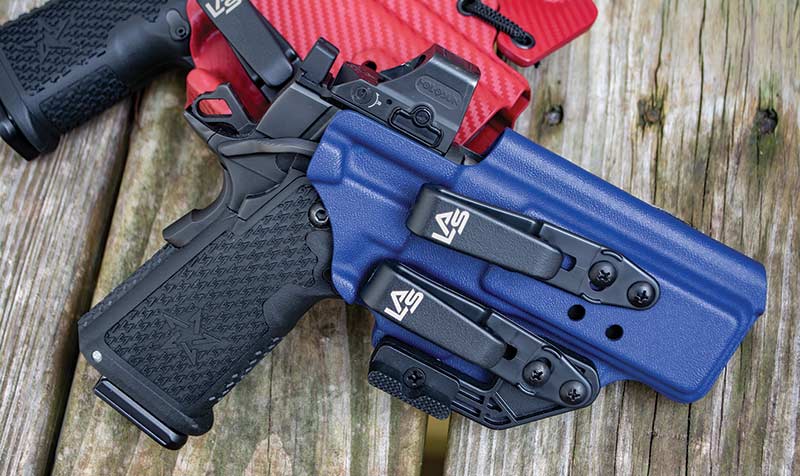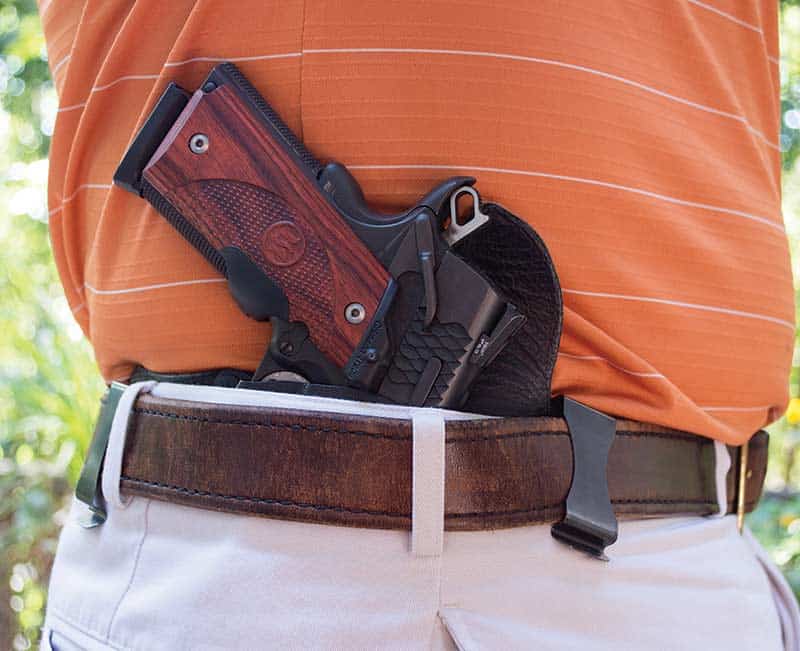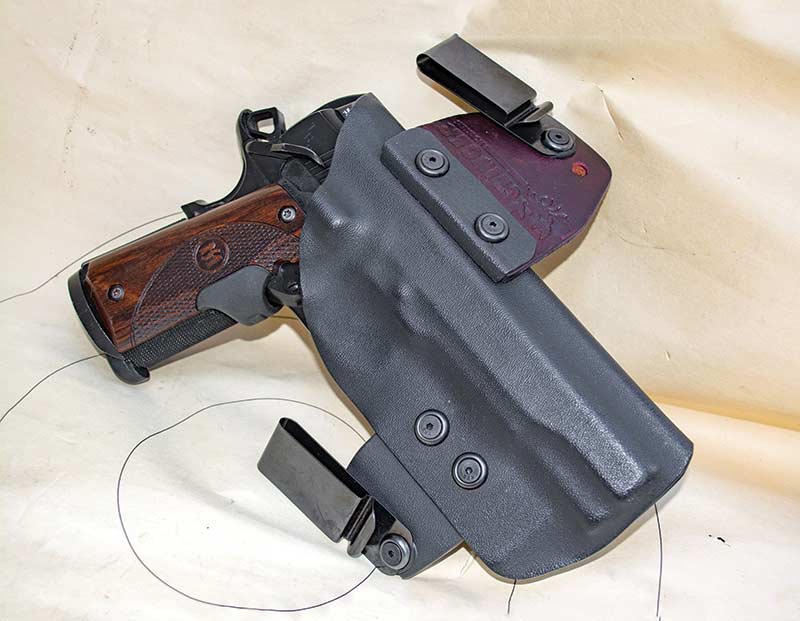False Assumptions!
You Most Certainly Can Carry a Larger Gun
At the risk of tipping some sacred cows, I’m going to make a bold statement here.
Yes, you can.
I’m saying you can carry a larger gun concealed — every day even. To be clear, I’m not talking about one more powerful or in a larger caliber. I’m talking about a handgun physically bigger than the pocket micro mini subatomic ultra-compacts all the rage these days.
Don’t get me wrong. I think it’s great we have choices of pocket-sized guns with double-stack 9mm or .380 ACP magazines packing round counts in the double digits. Those can be handy for sure. However, there are plenty of benefits to carrying a gun just a little more on the portly side.
I Like Big Guns and I Cannot Lie
A larger gun means more surface area, and this translates to better recoil control. Larger leads to heavier in most cases — another aid to keeping the muzzle on target through the recoil cycle. A bigger handgun also offers a longer sight radius. More space between the front and rear sights translates to more forgiving sighting. It’s much, much easier to shoot accurately when there is more distance between the sights. Last, but not least, a physically larger handgun can hold more ammo. To date, no one relying on a handgun for self-defense has complained about having too many rounds leftover.
For me, all of these “larger gun” benefits boil down to a higher level of confidence. Even without extra available rounds, I am more likely to be able to hit my intended target, especially while under stress. Try running a timed, challenging course of fire with a pocket compact. Then try it with a significantly larger gun. What do you think the results will reflect? If you ever have to make a precise shot under pressure, are you more likely to succeed with a micro-compact or full-sized handgun?
Excuses, Excuses
I’ve lost count of the number of times I’ve heard laments along the lines of, “I can’t carry a (insert mid-size gun model here). I (choose one of the following: am too small, am forced to wear a suit or dress to work, can’t conceal it, find it too heavy, wear shorts and T-shirts most of the time, etc.).” The list goes on and on.
My response is simple. Bull! Yes, you can. There are very few cases of “can’t” at play in the decision to carry a mid- or full-size gun. There are an infinite number of cases of “I’m not willing,” though. “Can’t” and “won’t” are very different things.
As my grade school teacher, Miss Schermerhorn, used to say, “If you’re cheating, you’re only hurting yourself!” In this case, “cheating” is admitting defeat out of laziness.
Larger Gun Carry Secrets
You don’t need NFL linebacker body proportions to carry a mid- or even full-size gun. It may not be as effortless and convenient as packing a pocket mini-sub-micro-compact, but you sure as heck can hide a larger handgun if you want.
For purposes of this discussion, let’s stick to on-body carry. Sure, you can always use a briefcase, purse, fanny pack or some other “off-body” approach. Here, we’re going to stick to on-body methods only and “all day, every day” solutions.
Before we start, be honest with yourself and recognize the difference between concealment and convenience. It’s always easier to carry a tiny gun — no argument here.
IWB Free Benefits
Inside the waistband (IWB) carry has been so popular for so long, in part, because you get free concealment benefits. When hiding a gun, think about three dimensions: length, thickness and height. With IWB carry, length is largely irrelevant (free concealment) because the barrel and slide are inside your pants or skirt. To a lesser degree, thickness worries are also minimized. A sharp eye might spot a fabric bump but let’s be real, passersby are more focused on their phones than staring at your midsection.
So, all you really must worry about is hiding the grip section, which is all above the beltline. Generally, a short and natural cover garment like an untucked shirt will handle this.
Dealing with the Grip
Even with a cover garment, the grip presents a challenge. You’ve usually got 1.3″ or so of gun width, plus the holster thickness protruding out the side of your body. Unless the gun is carefully snugged in to follow the contour of your shape, the bottom of the grip will tend to jut out — more so when you lean forward or bend over as the motion creates a tenting effect.
I like to use a holster specifically designed to draw the grip in toward your body. The Clinger Holsters No Print Wonder (now called the IWB Hinge holster) does a marvelous job of this using a clever hinge system. The holster body is rigid Kydex, as is the rear clip. The front belt clip is attached via a rubber or leather flap, which acts as a hinge. The flexibility, plus the extended location in the rear, draws the grip in tight when you attach the rear clip to the beltline. Worn at the 3 to 4 o’clock position, the system works like a champ. The full-height grip of a large pistol, like a 1911 or service pistol, tucks in close and doesn’t tent the back of your cover garment. It really works. I regularly carry a 1911, full-size SIG SAUER P320 and other similar guns wearing shorts and a T-shirt for cover. Piece of cake.
For additional comfort, attach the optional Clinger Cushion. Attaching to the back of any Kydex-type holster body with included Velcro dots, it places a pad between the hard holster shell and your body. I’ve outfitted all my traditional IWB holsters with them.
I’ve also had success with hybrid IWB holsters. For larger guns, I’ve drifted to the Alien Gear standard Cloak Tuck 3.5 model. It’s similar to leather and Kydex hybrid models with large backers and a thin but sturdy holster shell, but offers some critical benefits. The backing of the Cloak Tuck is a multi-layered affair to create moisture barriers and comfort, but the important layer is invisible — smack in the middle. A thin steel layer provides support and rigidity, aiding concealment by bringing the grip in close to the body. The steel also ensures the top flap won’t droop with age and use, presenting an obstacle to one-handed reholstering.
As a proof-of-concept experiment, I carried an FNX-45 Tactical, a huge, double-stack .45, with one of these and it’s doable using nothing more than a T-shirt as a cover garment.
Consider Appendix Carry
Counterintuitively perhaps, I’ve figured out I can more easily hide a larger gun in the appendix position than on the strong-side hip. In most cases, for men or women, the chest and shoulder areas are larger than the waist, so there’s a natural draping effect of a shirt or other top garment over the appendix zone. The area is backstopped by your body, so nothing protrudes from the side. I’ve found concealment of even a larger gun like the Staccato 2011 double-stack P model to be outstanding.
The technology to make appendix carry work is a bit different from that of the strong-side IWB position. First, use a foam wedge on the back of the holster, with the angle diminishing toward the top. This pushes the muzzle out and away from your body while driving the grip closer. If you have a few extra pounds in the waist area, this accessory makes all the difference. While the angling from the foam wedge aids concealment, it also increases safety by keeping the muzzle pointed more at the ground. The second key ingredient is a wing placed under the trigger guard. Much like the hinge system on the Clinger IWB holster, this extension presses against the backside of your belt, driving the grip closer to your body.
I’ve been carrying that full-sized Staccato as an everyday carry pistol using two different holsters from LAS Concealment: the Ronin 3.0, which offers a hinged magazine carrier, and the Shogun, offering a dedicated two-clip approach for gun only. Both make this fairly large pistol disappear when wearing just shorts and a T-shirt.
I’ll never argue with the convenience of carrying a tiny-micro-mini, but I’m a heck of a lot more confident in my shooting capabilities when using a physically larger handgun. With the right gear and some commitment, you don’t have to limit yourself to a mouse gun for daily carry.
For more info:
ClingerHolsters.com,
AlienGearHolsters.com,
LASConcealment.com,
Staccato2011.com
Subscribe To American Handgunner

Get More Carry Options content!
Sign up for the newsletter here:














